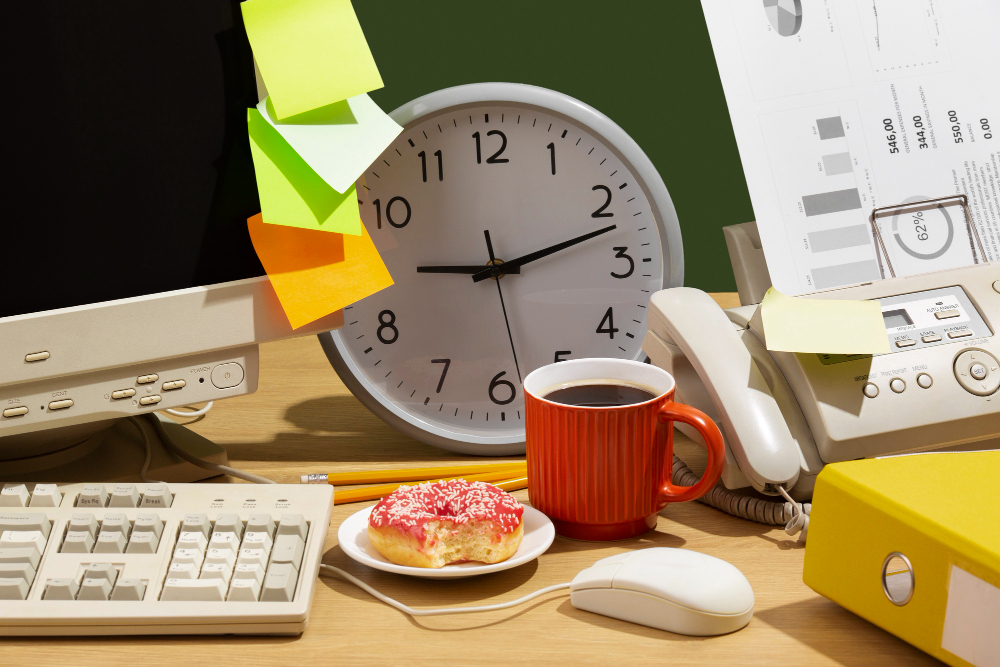leaders are constantly searching for effective ways to improve efficiency in the workplace. A study from Harvard Business Review reveals that companies with highly engaged and efficient teams show profitability rates up to 21% higher than their peers.
Finding sustainable ways to improve efficiency in the workplace is not about working longer hours, it is about working smarter through better systems, tools, and habits.
This guide will explore nine powerful ways to improve efficiency in the workplace that can transform your team’s output and morale.
The pursuit of effective ways to improve efficiency in the workplace goes beyond simple time management. It involves creating an environment where both individuals and teams can perform at their best, minimizing friction and maximizing value creation.
Whether you lead a small team or an entire department, these strategies will provide a comprehensive framework for enhancing performance across your organization.
From optimizing workflows to fostering better communication, let’s examine the most impactful approaches to workplace efficiency.
Optimize workflows and processes
Inefficient workflows represent one of the biggest drains on organizational productivity. Streamlining these processes is among the most fundamental ways to improve efficiency in the workplace.
Map out current workflows
You cannot improve what you do not understand. Begin by visually mapping out your team’s key workflows from start to finish.
- Identify all steps in a process, from initiation to completion.
- Note who is responsible for each step and how long it typically takes.
- Look for bottlenecks, unnecessary steps, or delays between stages.
- Identify areas where work waits for approval or handoffs between team members.
This visual representation often reveals surprising inefficiencies that have become normalized over time. Process mapping provides the clarity needed to implement targeted ways to improve efficiency in the workplace.
Eliminate redundancy and simplify processes
Once you have mapped your workflows, systematically eliminate unnecessary steps.
- Combine similar tasks that are currently handled separately.
- Remove approval steps that do not add genuine value.
- Automate repetitive tasks where possible.
- Standardize procedures for common activities to reduce decision fatigue.
According to research from McKinsey, organizations that systematically redesign their workflows can achieve productivity improvements of 20 to 30 percent.
This methodical approach to simplification represents one of the most impactful ways to improve efficiency in the workplace.
Implement smart time management strategies

How your team manages its time directly determines overall efficiency. Introducing proven time management methods can yield significant improvements.
Adopt the Pomodoro Technique for focused work
The Pomodoro Technique, which can be implemented using the Focary timer, is particularly effective for knowledge work.
- Work on a single task with full focus for 25 minutes.
- Take a mandatory 5 minute break to rest and recharge.
- After four sessions, take a longer break of 15 to 30 minutes.
- Use the breaks to stretch, hydrate, or briefly socialize.
This rhythm helps maintain high concentration levels while preventing burnout. Encouraging this practice across your team is one of the simplest yet most powerful ways to improve efficiency in the workplace.
Establish focused work periods
Create blocks of time dedicated to deep, uninterrupted work.
- Designate specific hours as “focus time” with minimal meetings or interruptions.
- Encourage team members to schedule their most demanding cognitive work during these periods.
- Use shared calendars to mark these blocks as busy to respect colleagues’ focus time.
- Lead by example by protecting your own focused work periods.
Research from the University of California Irvine found that it takes an average of 23 minutes to regain deep focus after an interruption. Protecting focused work time is therefore among the most valuable ways to improve efficiency in the workplace.
Leverage technology and automation

Strategic technology implementation can dramatically reduce manual effort and human error, freeing your team for higher value work.
Identify automation opportunities
Systematically review repetitive tasks that could be automated.
- Document processes that involve copying data between systems.
- Identify routine reporting that could be generated automatically.
- Look for manual approval workflows that could be streamlined.
- Consider customer service inquiries that follow predictable patterns.
Tools like Zapier, Microsoft Power Automate, or custom scripts can often handle these tasks more reliably and efficiently than manual processes. Strategic automation represents one of the most scalable ways to improve efficiency in the workplace.
Select tools that integrate well
The technology landscape is filled with promising tools, but poor integration creates new inefficiencies.
- Choose tools that connect seamlessly with your existing systems.
- Prioritize platforms with open APIs for future customization.
- Consider the learning curve and training requirements for new tools.
- Evaluate the total cost of ownership, including implementation and maintenance.
A well integrated tech stack reduces context switching and data silos. Making thoughtful technology decisions is crucial for finding sustainable ways to improve efficiency in the workplace.
Foster effective communication practices

Poor communication costs organizations significant time and resources through misunderstandings, rework, and missed opportunities.
Establish communication norms
Create clear guidelines for how and when to use different communication channels.
- Use email for formal communications that require documentation.
- Utilize instant messaging for quick questions and informal updates.
- Reserve meetings for discussions that truly require real time collaboration.
- Designate specific channels for different types of projects or topics.
These norms reduce communication overload and ensure messages reach the right people through the appropriate medium. Establishing communication protocols is among the most overlooked ways to improve efficiency in the workplace.
Optimize meeting practices
Meetings are necessary but often inefficient. Implementing better meeting practices can reclaim countless hours.
- Always create and distribute an agenda with clear objectives beforehand.
- Invite only essential participants to each meeting.
- Start and end meetings punctually to respect everyone’s time.
- Designate someone to take notes and document action items with owners and deadlines.
- Consider whether a meeting could be replaced by an email, memo, or brief video update.
According to a study published in the Harvard Business Review, executives spend an average of 23 hours per week in meetings. Improving meeting efficiency represents one of the most immediately impactful ways to improve efficiency in the workplace.
Cultivate a culture of continuous improvement

Efficiency is not a one time project but an ongoing practice. Building habits of reflection and optimization ensures lasting benefits.
Implement regular feedback loops
Create structured opportunities for identifying inefficiencies.
- Conduct brief retrospective meetings at the end of projects.
- Create simple channels for submitting improvement suggestions.
- Regularly review key performance indicators as a team.
- Celebrate efficiency improvements and learn from setbacks.
These practices help identify new ways to improve efficiency in the workplace as conditions change and new opportunities emerge.
Encourage skill development and cross training
Investing in your team’s capabilities pays long term efficiency dividends.
- Identify skill gaps that create bottlenecks in your workflows.
- Provide training on both technical skills and productivity methods.
- Implement job rotation or shadowing programs to build versatile teams.
- Encourage knowledge sharing through mentoring or internal presentations.
Teams with diverse skills and deep expertise can solve problems more quickly and adapt to changing demands. Strategic skill development is one of the most sustainable ways to improve efficiency in the workplace.
Design an optimal physical and digital workspace

The environment in which your team works significantly impacts their ability to focus and perform efficiently.
Organize the physical workspace for productivity
Thoughtful office design can reduce distractions and facilitate collaboration.
- Create distinct zones for focused work, collaboration, and relaxation.
- Ensure adequate lighting, comfortable temperatures, and minimal noise pollution.
- Provide the necessary tools and equipment within easy reach.
- Implement clear organization systems for shared resources.
A well designed physical environment removes unnecessary friction from the workday. Workspace optimization offers practical ways to improve efficiency in the workplace through environmental design.
Minimize digital clutter and distractions
Digital disorganization can be just as detrimental as physical clutter.
- Establish clear naming conventions and folder structures for digital files.
- Implement a systematic approach to email management.
- Use project management tools to centralize information instead of relying on scattered documents and messages.
- Encourage digital minimalism by regularly archiving old files and unsubscribing from unnecessary notifications.
Reducing digital friction helps team members find information quickly and maintain focus. Managing the digital environment is among the most modern ways to improve efficiency in the workplace.
Set clear goals and priorities

Without clear direction, teams waste energy on low impact activities. Strategic alignment ensures everyone works toward common objectives.
Implement objective and key results
The OKR framework helps align individual and team efforts with organizational priorities.
- Set ambitious but achievable objectives for each quarter.
- Define 3 to 5 measurable key results for each objective.
- Ensure key results are quantitative and time bound.
- Regularly track progress and adjust strategies as needed.
This clarity helps teams prioritize effectively and avoid scope creep. Goal setting frameworks provide structural ways to improve efficiency in the workplace by ensuring alignment.
Establish clear priorities and decision making authority
Ambiguity about priorities and authority leads to delays and duplicated efforts.
- Clearly communicate organizational and team priorities.
- Define who has decision making authority for different types of issues.
- Establish escalation paths for when teams encounter blockers.
- Empower team members to make decisions within their areas of responsibility.
Reducing ambiguity about what matters most and who can decide enables faster progress. Clear priorities and authority represent foundational ways to improve efficiency in the workplace.
Promote wellbeing and prevent burnout

Exhausted employees cannot perform efficiently. Sustainable performance requires attention to energy management and work life balance.
Encourage regular breaks and time off
Continuous work without adequate recovery leads to diminishing returns.
- Normalize taking full lunch breaks away from desks.
- Encourage using vacation time completely without work interruptions.
- Respect boundaries between work and personal time.
- Model healthy work habits as a leader.
Teams that rest properly during off hours return with more energy and creativity. Protecting recovery time is among the most human centered ways to improve efficiency in the workplace.
Monitor workload distribution
Uneven workload distribution creates both burnout and underutilization.
- Regularly review how work is distributed across team members.
- Use workload management tools to visualize capacity and allocations.
- Redistribute tasks when certain team members become overloaded.
- Develop backup plans for critical roles to manage absences.
Balanced workloads prevent bottlenecks and maintain consistent team performance. Workload management offers practical ways to improve efficiency in the workplace while protecting team health.
Implementing these ways to improve efficiency in the workplace requires commitment but delivers substantial returns through higher productivity, better morale, and improved business outcomes.
The most effective approach combines process optimization with time management strategies like the Pomodoro Technique, available through Focary, supported by clear communication and the right tools.
Remember that sustainable efficiency comes from creating systems that support both performance and wellbeing, not from pushing people to work harder or longer.
Start with one or two areas that represent the greatest opportunity for your team, implement changes systematically, and measure the impact.
As these practices become embedded in your culture, you will discover that the pursuit of efficiency becomes a natural part of how your organization operates, leading to continuous improvement and lasting competitive advantage.
Ready to stop being distracted and start achieving your goals?
Start your first Pomodoro session with Focary today and reclaim your focus.
Start Focusing Now